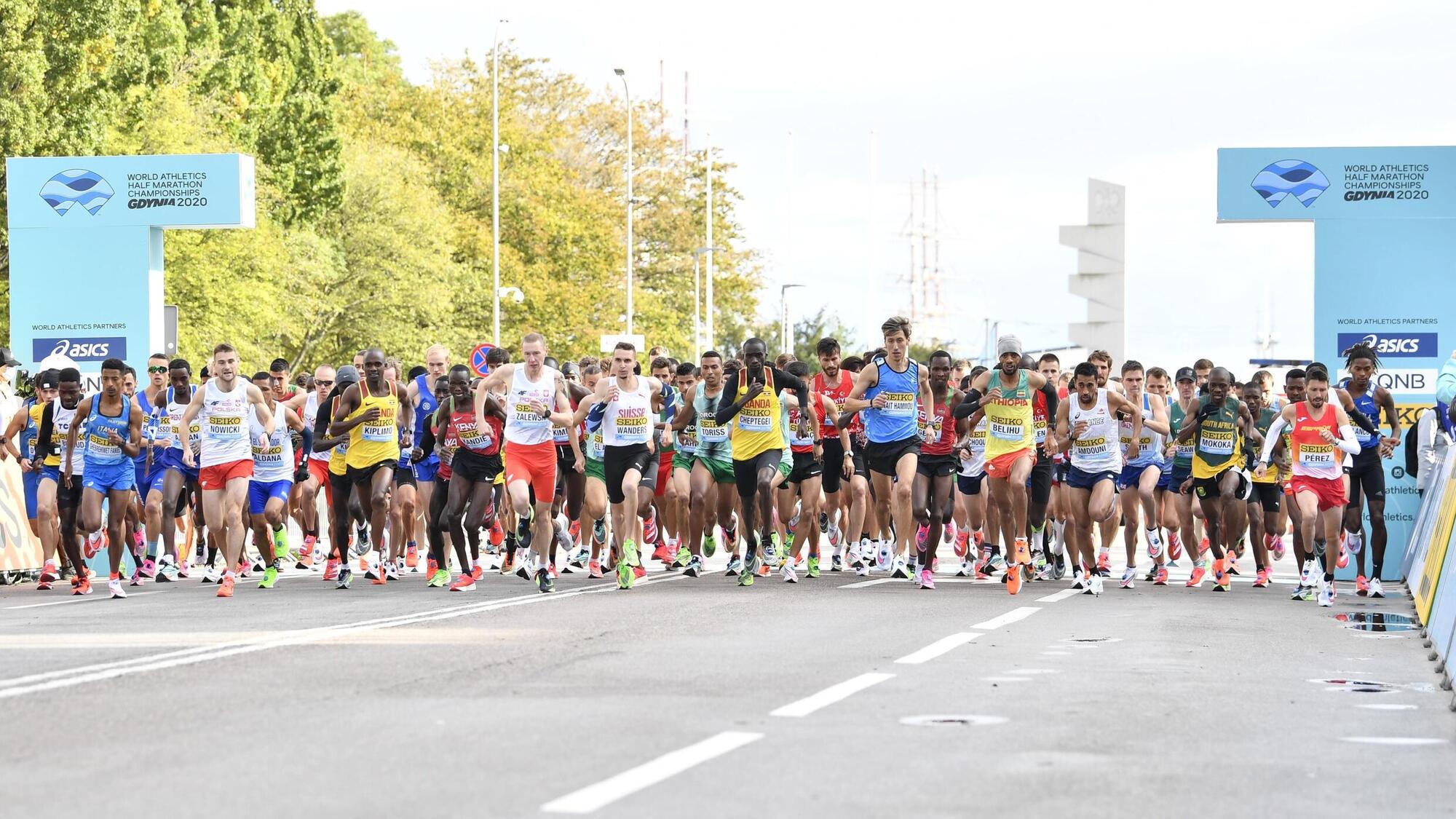

Featured
How Long From Couch To Half Marathon
Modified: January 22, 2024
Get off the couch and conquer a half marathon! Join our Featured program to go from zero to 13.1 miles in no time
Introduction
Welcome to the exciting journey of going from the couch to completing a half marathon. Whether you are a beginner runner looking to challenge yourself or someone who wants to get back into running after a break, this article will guide you through the process of training for a half marathon.
Running a half marathon is a significant accomplishment that requires commitment, discipline, and motivation. It is a race that covers a distance of 13.1 miles (21.1 kilometers) and is a popular choice for both seasoned runners and those new to the sport.
Training for a half marathon is a gradual process that involves building your endurance, improving your fitness level, and preparing both physically and mentally for the race. This article will provide you with essential tips and guidance to help you achieve your goal of completing a half marathon.
Embarking on this journey can be both daunting and exciting. It’s important to approach it with a positive mindset and a realistic understanding of what lies ahead. While running a half marathon requires effort and dedication, with proper training and consistency, it is an achievable goal for individuals of all fitness levels.
Whether you have never run before or have some prior running experience, this article will provide you with the necessary steps to go from the comfort of your couch to crossing the finish line of a half marathon.
In the following sections, we will discuss topics such as assessing your current fitness level, creating a training plan, incorporating cross-training and strength training, understanding the importance of rest and recovery, preventing injuries, fueling your body with the right nutrition, mentally preparing yourself, staying motivated throughout the training, tapering down in the final weeks, and race day strategies and tips.
Ready to lace up your running shoes? Let’s dive into the details of training for a half marathon and set you on the path to success!
Setting a Goal: From Couch to Half Marathon
As you embark on your journey from the couch to a half marathon, the first step is to set a clear and achievable goal. Having a defined goal helps to provide motivation and focus throughout your training.
Start by determining what motivates you to run a half marathon. Is it to challenge yourself, improve your fitness, or cross an item off your bucket list? Identifying your underlying motivation will keep you committed and determined even when the training gets tough.
Once you have established your motivation, it’s time to set a realistic goal for your half marathon. Consider factors such as your current fitness level, previous running experience, and the amount of time you have to dedicate to training.
Setting a specific goal, such as completing a half marathon within a certain time frame or finishing without walking, can help structure your training and guide your progress. Remember to make your goal attainable and personally meaningful to you.
It’s also essential to ensure that you allow enough time for proper training. A typical half marathon training program lasts around 12-16 weeks, depending on your fitness level and experience. Gradual and consistent training is key to avoid overexertion and reduce the risk of injuries.
Consider seeking guidance from a running coach or utilizing online training programs that cater to individuals starting from a couch-to-half-marathon level. These resources provide structured training plans tailored to your specific needs and goals.
Remember that everyone’s journey is unique, and progress may vary. Be flexible with your goals and adapt your training plan as needed. It’s crucial to listen to your body and make adjustments to your training schedule to prevent burnout or injury.
Setting a goal for your half marathon not only gives you something to strive for, but it also helps you stay focused and motivated throughout your training. Embrace the challenge and stay committed to your goal, and soon enough, you’ll be crossing the finish line of your first half marathon.
Assessing Your Current Fitness Level
Before you begin your half marathon training journey, it is essential to assess your current fitness level. Understanding where you are starting from will help you tailor your training plan to your specific needs and abilities.
Start by evaluating your cardiovascular fitness. You can do this by performing a cardio assessment test, such as a timed run or walk. This will give you an idea of your current endurance and aerobic capacity. Additionally, you can monitor your heart rate during exercise to gauge your fitness level.
Assessing your muscular strength and endurance is equally important. Consider performing exercises like push-ups, planks, squats, and lunges to determine your strength level. Pay attention to how many repetitions you can comfortably perform and the level of difficulty you experience.
Another critical aspect to consider is your flexibility. Flexibility exercises like stretching or yoga can help assess your current range of motion. Improving flexibility is essential for proper running form and injury prevention.
Don’t forget to evaluate your current running experience. If you are starting from scratch, your training plan will look different from someone who has been running regularly. Consider your running history, even if it was sporadic or from a few years ago.
Mental preparation is just as important as physical fitness assessment. Reflect on your mindset, motivation, and mental resilience. Are you mentally prepared for the challenges and dedication that come with half marathon training?
Keep in mind that the purpose of assessing your fitness level is not to compare yourself to others but to establish a starting point for your training. Embrace your current fitness level, and remember that everyone has to start somewhere.
Once you have a clear understanding of your current fitness level, you can set realistic goals and develop a training plan that gradually progresses from your current capabilities. Assessing your fitness level allows you to track your progress over time and celebrate your achievements along the way.
Remember, the half marathon journey is about continuous improvement, challenging yourself, and pushing your limits. Embrace the process, and get ready to surprise yourself with what you can achieve.
Creating a Training Plan
With your goals set and your current fitness level assessed, it’s time to create a training plan that will take you from the couch to the finish line of a half marathon. A well-structured training plan will help you progressively build your endurance, improve your running technique, and minimize the risk of injury.
Start by determining how many days per week you can dedicate to training. Three to four days of running is a good starting point for beginners, with additional days for cross-training and rest. Remember, rest days are just as important as training days, as they allow your body to recover and adapt to the training stimulus.
Gradual progression is key in any training plan. Begin with a mix of running and walking intervals that gradually increase in duration. As you build your aerobic capacity and endurance, you can gradually decrease the walking intervals and increase your running time.
Incorporating a variety of running workouts is important to develop both speed and endurance. Replace one of your weekly runs with a tempo run, where you run at a comfortably hard pace for a set distance or time. Additionally, include one longer run per week to build your endurance.
Cross-training activities can complement your running training by providing cardiovascular exercise and strengthening different muscle groups. Activities such as cycling, swimming, or strength training can help prevent overuse injuries and improve overall fitness.
Be sure to incorporate rest and recovery days into your training plan. Rest days allow your body to repair and regenerate, reducing the risk of burnout and injuries. Use these days for gentle stretching, mobility exercises, or engaging in low-impact activities like yoga or walking.
Consistency is key when following a training plan. Stick to the scheduled runs and cross-training sessions as much as possible. However, life happens, and it’s okay to make slight adjustments to your plan when needed. Be flexible and adapt your training schedule to fit your circumstances.
Regularly reassess your progress and make adjustments to your training plan as necessary. Keep a training journal to track your mileage, times, and how you feel after each run. This will help you monitor your progress, identify patterns, and make informed decisions about when to progress to more challenging workouts.
Remember, a training plan should not be overly ambitious or make you feel overwhelmed. It should be a tool to guide and support your progress. Stay consistent, listen to your body, and gradually increase the intensity and duration of your runs. With a well-designed training plan, you’ll be well on your way to conquering the half marathon distance.
Building Endurance: Start Slow and Gradually Increase
Building endurance is a crucial component of training for a half marathon. It allows your body to adapt to the demands of longer distances and helps you maintain a steady pace throughout the race. However, it’s important to approach it with patience and a gradual progression mindset.
When starting your journey from the couch to a half marathon, it’s essential to begin with a realistic distance and pace. Starting slow and gradually increasing your mileage will reduce the risk of injury and allow your body to adapt to the demands of running longer distances.
Begin by incorporating a mix of running and walking intervals into your training. For example, you might run for two minutes and then walk for one minute, alternating between the two for a set duration. As your endurance improves, gradually decrease the walking intervals and increase your running time.
Consistency is key when building endurance. Aim to run three to four times a week, gradually increasing your overall mileage over time. Avoid the temptation to ramp up your mileage too quickly, as this can lead to overuse injuries and burnout.
It’s important to listen to your body and pay attention to any warning signs of overtraining. Watch for symptoms such as excessive fatigue, persistent muscle soreness, or a decline in performance. If you experience any of these symptoms, consider adding an extra rest day or reducing the intensity of your workouts.
Incorporating a long run into your weekly training routine is crucial for building endurance. Start with a comfortable distance, such as 3-4 miles, and gradually increase it by 10% each week. This gradual progression will allow your body to adapt and improve its stamina.
While building endurance, it’s important to prioritize consistency over speed. Focus on maintaining a steady and conversational pace during your runs. As your training progresses and your endurance improves, you can gradually introduce speed workouts and tempo runs to increase your overall pace.
Remember to stay patient and trust in the process. Building endurance takes time, and progress may not always be linear. Some days will feel easier than others, and that’s perfectly normal. Embrace the journey, celebrate small victories, and trust that your body is adapting and becoming stronger with each run.
By starting slow and gradually increasing your mileage and training intensity, you’ll lay a solid foundation for building endurance. The key is consistency, patience, and listening to your body’s cues. With time and dedication, you’ll be amazed at the progress you can make on your way to completing a half marathon.
Incorporating Cross-Training
When training for a half marathon, it’s important to incorporate cross-training activities into your routine. Cross-training involves engaging in other forms of exercise to complement your running training and provide a well-rounded approach to fitness. By incorporating cross-training, you can improve your overall endurance, strength, and flexibility, while also reducing the risk of overuse injuries.
One popular cross-training activity that complements running is cycling. Cycling is a low-impact exercise that provides aerobic conditioning and works different muscle groups than running. It helps build leg strength and cardiovascular fitness while reducing the impact on your joints.
Swimming is another excellent cross-training option. It is a full-body workout that promotes cardiovascular fitness, improves lung capacity, and strengthens muscles. Swimming is particularly beneficial for runners as it provides a non-weight-bearing exercise that gives your joints a break while still improving cardiovascular endurance.
Strength training is crucial for runners as it helps improve running economy, stability, and muscle balance. Focus on exercises that target your lower body, such as squats, lunges, and deadlifts, to strengthen your glutes, quads, and hamstrings. Additionally, incorporate core exercises like planks and bridges to enhance stability and improve posture.
Yoga and Pilates are excellent options for improving flexibility, core strength, and balance. These practices can help prevent injuries, promote relaxation and mental focus, and improve overall body awareness. Regular stretching and flexibility exercises are also key to maintaining healthy muscles and joints for running.
When incorporating cross-training into your schedule, aim for two to three sessions per week, alternating between different activities. This variety helps prevent boredom, keeps your body challenged, and allows for recovery between running sessions.
Remember to listen to your body and balance your cross-training activities with your running training. Avoid overloading your schedule with too many intense workouts that could increase the risk of fatigue or injury. Prioritize adequate rest days to allow your body to recover and adapt to the combined training load.
Ultimately, cross-training activities should complement your running training and enhance your overall fitness. Experiment with different activities to find what you enjoy and what works best for your body. Incorporating cross-training into your routine will not only make you a stronger and more well-rounded runner but will also add variety and enjoyment to your training journey.
Strength Training for Runners
Strength training is a vital component of a well-rounded training program for runners. Incorporating strength training exercises into your routine can improve running performance, reduce the risk of injuries, and enhance overall physical fitness. By targeting specific muscle groups and enhancing muscle strength, endurance, and power, strength training can help you become a stronger and more efficient runner.
When designing your strength training program, focus on exercises that target the key muscle groups used in running. These include the glutes, quadriceps, hamstrings, calves, and core muscles.
Strong glutes are crucial for stabilizing the hips and providing power during running. Exercises such as squats, lunges, and glute bridges help strengthen the glute muscles and improve overall running form.
The quadriceps and hamstrings play a significant role in the propulsion and deceleration phases of running. Incorporate exercises like leg presses, step-ups, and hamstring curls to target and strengthen these muscle groups.
Strong calf muscles provide stability and power during push-off in each stride. Calf raises, both with straight legs and bent knees, are effective exercises for strengthening the calf muscles.
Don’t forget about your core muscles! A strong core improves posture, stability, and overall running efficiency. Planks, Russian twists, and bicycle crunches are excellent exercises for targeting your abs, obliques, and lower back muscles.
In addition to specific exercises, incorporating plyometric exercises into your strength training routine can help improve power and explosiveness. Plyometric exercises like jump squats, box jumps, and bounding mimic the explosive movements involved in running and can enhance your speed and running economy.
When performing strength training exercises, focus on using proper form and technique. Start with lighter weights or bodyweight exercises and gradually increase the intensity as your strength improves. It’s better to prioritize good form over heavy weights to minimize the risk of injury.
Consider incorporating two to three strength training sessions into your weekly training schedule, allowing for at least one day of recovery between sessions. This will give your muscles time to repair and rebuild, promoting strength gains and reducing the risk of overuse injuries.
Remember that strength training should supplement your running training and not replace it. Prioritize your running workouts and schedule strength training sessions accordingly.
Finally, listen to your body and adjust your strength training program as needed. If you feel excessive fatigue or muscle soreness, take additional rest days or reduce the intensity of your strength training sessions to allow for proper recovery.
By incorporating regular strength training exercises into your routine, you can improve your running performance, reduce the risk of common running injuries, and become a stronger and more efficient runner. Embrace the challenge, have patience, and enjoy the benefits of a well-rounded training program.
Rest and Recovery: Listening to Your Body
Rest and recovery are essential components of any half marathon training program. While it may be tempting to push yourself to the limit, it’s crucial to listen to your body and give it the time it needs to rest and repair. Incorporating sufficient rest and recovery into your training plan will help prevent overtraining, reduce the risk of injuries, and optimize your performance on race day.
Rest days are just as important as training days. They provide your body with the opportunity to recover and adapt to the stress of running. Use rest days to engage in light activities like walking, stretching, or yoga. Allow your body to recharge and replenish energy levels.
Recovery runs can also be beneficial. These are short, easy-paced runs done the day after a long run or a more intense training session. Recovery runs promote blood flow, aid in muscle repair, and can help reduce muscle soreness.
Listen to your body’s signals of fatigue, pain, or excessive soreness. If you feel unusually tired or experience persistent muscle soreness, consider taking an extra rest day or scaling back the intensity and volume of your training. Pushing through fatigue or pain can lead to overuse injuries and hinder your progress.
Use recovery tools such as foam rollers, massage balls, or massage therapy to help release muscle tension and improve circulation. These tools can aid in the recovery process by reducing muscle soreness and promoting faster recovery.
Proper sleep is crucial for recovery and overall well-being. Aim for seven to nine hours of quality sleep each night to allow your body ample time to repair and regenerate. Create a relaxing bedtime routine and prioritize sleep as an integral part of your training plan.
Nutrition plays a significant role in rest and recovery. Ensure you are fueling your body with a balanced diet that includes a variety of healthy carbohydrates, proteins, and fats. Adequate hydration is also crucial for optimal recovery. Aim to drink enough water throughout the day, especially before and after your training sessions.
Active recovery techniques such as yoga, swimming, or cycling can promote blood flow and help reduce muscle soreness. These low-impact activities can aid in recovery while providing a break from the impact of running.
Finally, listen to the mental aspect of rest and recovery. Give yourself permission to take breaks and find joy in other activities outside of running. Mental rest and relaxation are just as important as physical rest, helping to prevent burnout and maintain motivation throughout your training.
Remember that rest and recovery are not signs of weakness but essential components of a successful training program. By listening to your body, providing it with adequate rest, and implementing proper recovery strategies, you will optimize your training and perform at your best on race day.
Injury Prevention and Proper Form
Injury prevention is a crucial aspect of half marathon training. By following proper form and adopting injury prevention strategies, you can reduce the risk of setbacks and stay on track with your training. Paying attention to your body’s signals and implementing preventive measures will help you stay healthy and strong throughout your training.
One key aspect of injury prevention is maintaining proper running form. Focus on running tall with a slight forward lean and relaxed shoulders. Avoid overstriding, as landing with your foot too far ahead of your body can increase the risk of injury. Aim for a mid-foot strike to promote efficient running mechanics and reduce stress on your joints.
Regularly assess your running shoes and replace them when necessary. Running in worn-out shoes can lead to improper foot alignment and increase the risk of injuries. Invest in quality running shoes that provide proper support and cushioning for your foot type and running style.
Gradual progression is key to injury prevention. Avoid the temptation to increase your mileage or intensity too quickly. Gradually increase your training volume and intensity, allowing your body to adapt to the demands of running. Follow a structured training plan that includes adequate rest and recovery days.
Listen to your body’s signals and address any pain or discomfort promptly. Ignoring or pushing through pain can lead to more severe injuries. If you experience persistent pain or injuries, consult a healthcare professional or physical therapist for proper diagnosis and treatment.
Incorporating strength training exercises into your routine, as discussed earlier, is vital for injury prevention. Strong muscles help support your joints and protect against common running injuries. Focus on exercises that target muscle imbalances, strengthen your core, and promote stability and balance.
Proper warm-up and cool-down routines are essential before and after each run. Perform dynamic stretching exercises to warm up your muscles and increase blood flow. After your run, dedicate time to static stretching to improve flexibility and aid in muscle recovery.
Cross-training, as mentioned earlier, can also help prevent injuries. Engaging in activities like swimming, cycling, or yoga can strengthen different muscle groups, provide a break from high-impact running, and reduce the risk of overuse injuries.
Implementing a foam rolling routine can help release muscle tension and prevent tightness. Regularly rolling your muscles can improve mobility, prevent muscle imbalances, and aid in recovery.
Finally, listen to your body’s signals and give yourself permission to take rest days or modify your training when needed. Resting and allowing your body time to recover is not a sign of weakness but an essential part of injury prevention.
By prioritizing injury prevention and proper form in your training, you can reduce the risk of setbacks and ensure a successful half marathon journey. Take the time to listen to your body, incorporate preventive strategies, and enjoy the process of becoming a strong and injury-free runner.
Nutrition for Half Marathon Training
Nutrition plays a critical role in half marathon training, as proper fueling can optimize performance, enhance recovery, and support overall health. By adopting a well-balanced and nutrient-dense diet, you can ensure that your body has the energy and nutrients it needs to meet the demands of training and prepare for race day.
Carbohydrates are the primary source of fuel for endurance activities like running. Include complex carbohydrates such as whole grains, fruits, vegetables, and legumes in your diet. These provide sustained energy and also supply essential vitamins, minerals, and fiber.
Protein is essential for muscle repair and recovery. Include lean sources of protein such as chicken, fish, eggs, tofu, and legumes into your meals. Aim for a combination of carbohydrates and protein to promote optimal recovery after your runs.
Fats are an important fuel source for endurance athletes. Focus on consuming healthy fats like avocados, nuts, seeds, olive oil, and fatty fish to support overall health and provide long-lasting energy.
Hydration is crucial for optimal performance and recovery. Aim to drink enough water throughout the day, and especially before, during, and after your runs. Pay attention to your body’s thirst cues and use urine color as a guide for hydration – clear or pale yellow urine indicates good hydration.
Before your runs, focus on consuming a balanced meal or snack that includes carbohydrates for energy and a small amount of protein for muscle repair. Experiment with different foods to find what works best for you and avoids eating too close to your run to prevent discomfort.
During long runs, consider fueling with easily digestible carbohydrates such as energy gels, chews, or sports drinks to replenish glycogen stores and maintain energy levels. Practice your fueling strategy during training to find what works best for you and avoids consuming anything new on race day.
After your runs, prioritize post-workout nutrition to kickstart muscle recovery and replenish glycogen stores. Aim to consume a snack or meal with a combination of carbohydrates and protein within 30-60 minutes of finishing your run.
Be mindful of your overall calorie intake to ensure you are meeting your energy needs while maintaining a healthy weight. Running requires extra energy expenditure, but excessive calorie restriction can impact performance and compromise recovery. Focus on proper nourishment and balance.
Lastly, listen to your body and pay attention to how certain foods affect your energy levels and gastrointestinal comfort. Everyone’s dietary needs and tolerances can vary, so it’s important to find a nutrition plan that works best for you.
Consulting a registered dietitian or sports nutritionist can provide personalized guidance and help you develop a nutrition plan tailored to your specific needs and goals.
Remember, nutrition is a vital component of your half marathon training. By fueling your body with the right nutrients and maintaining adequate hydration, you can optimize your performance, enhance recovery, and support overall well-being during your training journey.
Mental Preparation: Overcoming Mental Barriers
Mental preparation is just as crucial as physical training when it comes to successfully completing a half marathon. Running long distances can be physically demanding, but it’s often the mental challenges that pose the biggest obstacles. By developing mental strength and preparing your mindset, you can push through mental barriers and achieve your goals.
Visualize success: Create a mental image of yourself crossing the finish line strong and proud. Visualizing success can help boost your confidence and motivation, especially during challenging moments in training or on race day.
Set realistic expectations: While setting ambitious goals is important, it’s also crucial to set realistic expectations. Recognize that there may be ups and downs throughout your training journey, and it’s okay to adjust your goals if needed. Celebrate small victories along the way and appreciate the progress you make.
Challenge negative thoughts: Negative thoughts and self-doubt can be detrimental to your performance. Practice recognizing negative thoughts and replacing them with positive affirmations. Remind yourself of your capabilities and focus on the progress you have already made.
Practice mental toughness: Pushing through discomfort and fatigue is part of the process. During your training runs, intentionally put yourself in challenging situations to build mental toughness. Run in adverse weather conditions or tackle hills and difficult terrains to develop resilience and mental strength.
Break down the race: Instead of focusing on the entire distance of a half marathon, break it down into smaller, more manageable segments. For example, focus on reaching the next mile marker or completing each 5K. This approach can make the race feel less daunting and help you stay mentally engaged throughout.
Develop positive mantras: Create a personal mantra or a few positive affirmations that resonate with you. Repeat these mantras to yourself during training runs and on race day to stay focused and motivated. Examples include “I am strong, I am capable” or “I can do this, one step at a time.”
Practice mindfulness and mental awareness: Incorporate mindfulness techniques into your training routine to help stay present and focused. Pay attention to your breathing, the sensations in your body, and the environment around you. Practicing mindfulness can help quiet the mind, reduce stress, and enhance your overall running experience.
Surround yourself with a supportive network: Surround yourself with positive and supportive individuals who understand and encourage your running journey. Share your goals and challenges with them, and lean on their support when you need it. Having a strong support system can significantly impact your mental resilience.
Lastly, embrace the enjoyment of running. Remember why you started this journey and find joy in the process. Focus on the present moment and appreciate the physical and mental benefits that running brings. Cultivate a positive mindset and believe in your ability to overcome any mental barriers you encounter.
By incorporating mental preparation into your training, you can develop the mental resilience and strength needed to conquer the challenges of a half marathon. With a positive mindset and a belief in your capabilities, you’ll be unstoppable on race day.
Staying Motivated Throughout the Training
Maintaining motivation throughout the duration of your half marathon training can be challenging. However, with the right strategies, you can stay inspired and focused on your goal. Here are some tips to help you stay motivated throughout your training:
Set realistic and achievable goals: Break down your long-term goal of completing a half marathon into smaller, attainable milestones. Celebrate each milestone as you progress, whether it’s running a certain distance or improving your pace. By setting these smaller goals, you’ll experience a sense of accomplishment along the way, keeping you motivated.
Train with a partner or join a running group: Running with a partner or joining a running group can provide great support and accountability. Not only will you have someone to share your experiences with, but you’ll also have someone to help push you and keep you motivated during training runs.
Vary your training routes: Running the same routes repeatedly can become monotonous and lead to a lack of motivation. Explore different running routes in your area, varying the scenery and terrain. Consider trail running or finding new parks or trails to keep your runs interesting and fresh.
Reward yourself: Set up a system of rewards for reaching specific training milestones. Treat yourself to something you enjoy, like a massage, a new piece of running gear, or a delicious healthy meal. Rewarding yourself along the way can provide an extra boost of motivation and serve as a reminder of your progress.
Track your progress: Keep a training journal or use a running app to track your mileage, pace, and overall progress. Seeing how far you’ve come can be highly motivating and inspire you to continue pushing forward. Plus, it allows you to reflect on your accomplishments and identify areas for improvement.
Find inspiration: Surround yourself with sources of inspiration. Follow running influencers on social media, read books or articles about running, and watch documentaries or videos of inspiring runners. Engage with the running community and seek motivation from others who have conquered the half marathon distance.
Switch up your training routine: Incorporate variety into your training by including different types of runs, such as tempo runs, interval training, or hill workouts. Mixing up your training routine not only prevents boredom but also challenges your body in different ways, keeping your motivation levels high.
Remember your “why”: Reflect on why you decided to take on the challenge of a half marathon. Whether it’s to improve your fitness, challenge yourself, support a cause, or simply prove to yourself that you can do it, remind yourself of the reasons that motivated you to start this journey. Keep those reasons at the forefront of your mind, especially during challenging training days.
Visualize success: Take some time to visualize yourself crossing the finish line of your half marathon. Imagine how accomplished and proud you will feel. Visualizing success can help you stay motivated and focused on your end goal, even during challenging moments.
Embrace the process: Lastly, remember that training for a half marathon is a journey. Embrace the process, including the highs and lows, the setbacks, and the achievements. Focus on the progress you make each day and remind yourself that every step forward is bringing you closer to your goal.
By implementing these strategies, you can maintain motivation and enthusiasm throughout your half marathon training. Stay focused, believe in yourself, and remember that you’re capable of achieving great things. Your hard work and dedication will pay off on race day!
The Final Weeks: Tapering Down and Preparing for Race Day
The final weeks leading up to your half marathon are a critical time for preparing your body and mind for race day. During this period, it’s important to taper down your training, focus on recovery, and fine-tune your race day preparations. Here are some key considerations for the final weeks:
Tapering down your training: Tapering is a gradual reduction in mileage and intensity in the weeks leading up to the race. This allows your body to recover from the accumulated fatigue of training while maintaining your fitness level. Reduce your mileage by about 20-30% each week leading up to the race, but continue to incorporate some shorter, more intense workouts to keep your body sharp.
Focus on recovery: Prioritize rest and recovery during the taper period. Your body needs time to repair and regenerate in order to perform at its best on race day. Get enough sleep, eat nutritious foods, and continue with light cross-training activities, such as swimming or gentle yoga, to promote blood flow and reduce muscle soreness.
Fine-tune your race day strategy: Use the taper period to finalize your race day strategy. Determine your pacing plan – whether you want to start conservatively or maintain a steady pace throughout the race. Familiarize yourself with the course elevation and plan your fueling and hydration strategy accordingly.
Practice your race day routine: Simulate race day conditions during your longer training runs. Wear the same gear, practice your fueling and hydration strategy, and envision yourself on race day. This will help you identify any potential issues and make necessary adjustments to your routine.
Stay consistent with your nutrition: Continue to fuel your body with a balanced and nutritious diet during the final weeks. This includes consuming adequate carbohydrates for energy, lean proteins for muscle repair, and healthy fats for overall health. Hydration should remain a priority, ensuring you are well-hydrated leading up to race day.
Manage stress and nerves: As race day approaches, it’s natural to feel nervous and anxious. Develop strategies to manage stress, such as deep breathing exercises, visualization, or meditation. Focus on positive thoughts and remind yourself of the hard work and preparation you have put in.
Stay injury-free: During the taper period, it’s important to avoid any activities that could lead to injury. Be cautious with new exercises or excessive cross-training activities that may strain your muscles or joints. Protect yourself by staying diligent with stretching, foam rolling, and body maintenance routines.
Trust your training: Have confidence in the training you’ve undergone. Trust in your body’s ability to perform on race day. Remind yourself of the miles you have logged and the obstacles you have overcome during your training. Believe in your preparation and trust that you are ready for the challenge.
Rest and conserve energy: In the final days leading up to the race, prioritize rest. Get enough sleep, avoid strenuous activities, and conserve your energy. Focus on staying mentally sharp and positive, visualizing success, and envisioning yourself crossing the finish line.
Remember that the taper period is a crucial part of your training. It allows your body to recover, restore glycogen stores, and be in peak condition for race day. Balance your physical preparation with mental readiness, and embrace the journey towards your half marathon goal.
Race Day Strategies and Tips
Race day is the culmination of your hard work and training. It’s an exciting and memorable experience that requires both physical and mental preparation. Here are some strategies and tips to help you make the most of your race day:
Arrive early: Give yourself plenty of time on race day to get organized and mentally prepared. Arrive early to the race venue to avoid any last-minute stress and ensure you have enough time to warm up, use the restroom, and familiarize yourself with the surroundings.
Stick to your routine: On race day, aim to follow the routines and strategies that have proven successful during your training. This includes your pre-race meal, warm-up routine, and any rituals that help you feel prepared and focused.
Start conservatively: Avoid the temptation to start the race too fast. Begin at a conservative pace that allows you to settle into your rhythm comfortably. Starting too fast can lead to early fatigue and make the later parts of the race more challenging.
Run to your race plan: Stick to your race plan and pacing strategy. Consistency is key, so aim to maintain a steady pace throughout the race. Break down the race into segments or landmarks and focus on getting through each one before thinking about the next.
Stay hydrated and fuel properly: Follow your pre-planned fueling and hydration strategy during the race. Make use of aid stations for water, sports drinks, or fuel if necessary. Practice taking fuel and hydrating during your long training runs to ensure your digestive system is accustomed to it on race day.
Stay mentally focused: Keep a positive mindset and stay mentally engaged throughout the race. Use positive affirmations, focus on your breathing, and draw inspiration from the fellow runners and cheering spectators. Embrace the energy of the race and use it to propel you forward.
Stay mindful of your form: Pay attention to your running form, especially as you start to tire. Keep your posture tall, maintain a relaxed upper body, and continue with your efficient running mechanics. Good form can help conserve energy and prevent unnecessary muscle fatigue.
Take advantage of crowd support: During the race, draw energy from the cheering crowds and use their support to motivate you. Smile, high-five spectators, and appreciate the atmosphere. The encouragement from others can boost your spirits and carry you through tough moments.
Stay adaptable: Be prepared for unforeseen circumstances during the race, such as changes in weather or unexpected challenges. Maintain a positive mindset and adapt your race strategy if needed. Trust in your training and your ability to handle any adjustments that come your way.
Enjoy the experience: Remember to savor the experience of running a half marathon. Take in the sights and sounds, appreciate the camaraderie of your fellow runners, and celebrate every step you take towards the finish line. Let the joy of the moment override any discomfort or fatigue.
Celebrate your achievement: When you cross the finish line, take a moment to celebrate your accomplishment. Embrace the sense of pride and fulfillment that comes with completing a half marathon. Take photos, collect your finisher’s medal, and revel in the feeling of achieving your goal.
Remember, race day is the culmination of your training, dedication, and determination. Embrace the challenge, stay focused, and have confidence in your abilities. Trust that you have what it takes to complete the half marathon and enjoy every moment of the journey.
Conclusion
Congratulations! You have reached the conclusion of this comprehensive guide on going from the couch to completing a half marathon. Throughout this article, we have covered various aspects of training, from setting goals to race day strategies. Now, armed with the knowledge and strategies shared, you are well-prepared to take on the challenge of a half marathon.
Remember that training for a half marathon is both a physical and mental journey. It requires dedication, commitment, and perseverance. As you progress through your training, embrace the challenges, celebrate your achievements, and stay motivated by reminding yourself of your initial goals and motivations.
Take the time to assess your current fitness level, create a training plan that suits your needs, and incorporate cross-training and strength training activities to enhance your performance and prevent injuries. Prioritize rest, recovery, and proper nutrition to support your training and optimize your overall well-being.
Maintain a positive mindset throughout your training, and develop strategies to overcome mental barriers. Ultimately, recognize that the journey is unique to you, and your progress may differ from others. Stay committed to your goals and trust the process. As the race day approaches, taper down your training, fine-tune your race day strategy, and take care of your body and mind.
On race day, stay focused, stick to your plan, and enjoy the experience. Embrace the support of fellow runners and spectators, and savor the thrill of crossing the finish line. Remember that completing a half marathon is an incredible achievement, regardless of your finishing time.
Whether this is your first half marathon or another milestone in your running journey, completing a half marathon is a testament to your determination, strength, and resilience. Cherish the memories, learn from the experience, and use it as a stepping stone for future challenges.
Now, it’s time to lace up your running shoes, hit the pavement, and embark on this incredible journey from the couch to the half marathon. Believe in yourself, stay consistent, and embrace the joy of running. You have the power to cross that finish line and achieve your goals. Good luck, and may your half marathon journey be filled with fulfillment and triumph!









